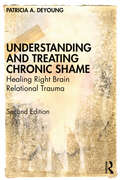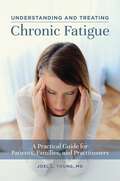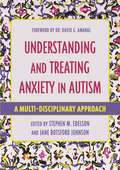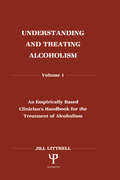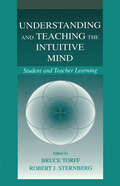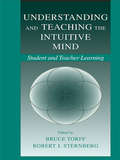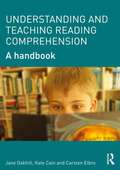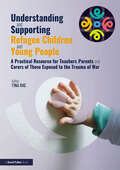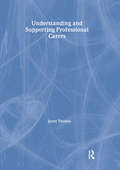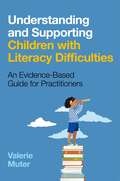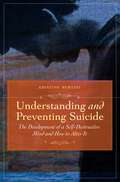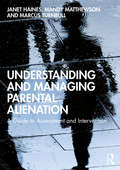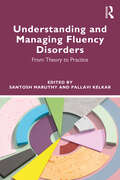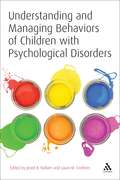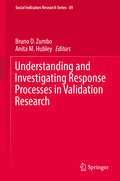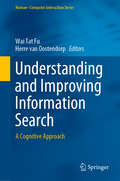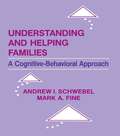- Table View
- List View
Understanding and Treating Chronic Shame: Healing Right Brain Relational Trauma
by Patricia A. DeYoungA masterful synthesis of relational and attachment theory, neurobiology, and contemporary psychoanalysis, Understanding and Treating Chronic Shame has been internationally recognized as an essential text on shame. Integrating new theory about trauma, shame resilience, and self-compassion, this second edition further clarifies the relational, right-brain essence of being in and with the suffering of shame. New chapters carry theory further into praxis. In the time of a national Truth and Reconciliation Commission and a global Black Lives Matter movement, "Societies of Chronic Shame" invites therapists to deepen their awareness of collective societal trauma and of their own place within dissociated societal shame. "Three Faces of Shame" organizes the clinical wisdom of the book into clear guidelines for differential diagnosis and treatment. Lucid and compassionate, this book engages with the most profound challenges of clinical practice and touches into the depths of being human.
Understanding and Treating Chronic Fatigue: A Practical Guide for Patients, Families, and Practitioners
by Joel L. YoungSome doctors still think Chronic Fatigue Syndrome is a "fake" diagnosis. In this book, Joel Young, MD, presents the research, experience, and treatments that prove otherwise.Millions of Americans experience chronic fatigue syndrome (CFS), a continuous exhaustion and a feeling comparable to that of having just run a marathon when all they have done is a daily living task, such as taking a shower or getting dressed.Doctors don't have tests for CFS, and some think it's a faux or psychological disorder. Joel Young, MD, in this heavily researched book, explains why it is a true physical illness and how it may be treated. He details how he successfully treats the symptoms, which can include severe fatigue, "brain fog," chronic pain, and sleep problems. Unlike doctors who recommend exercise, supplements, or opioid medications, Young integrates such options as long-acting stimulants, meditation, and dietary changes to reduce fatigue, as well as non-opioid drugs, medical marijuana, and self-help options including yoga for the associated chronic pain.
Understanding and Treating Chronic Fatigue: A Practical Guide for Patients, Families, and Practitioners
by Joel L. YoungSome doctors still think Chronic Fatigue Syndrome is a "fake" diagnosis. In this book, Joel Young, MD, presents the research, experience, and treatments that prove otherwise.Millions of Americans experience chronic fatigue syndrome (CFS), a continuous exhaustion and a feeling comparable to that of having just run a marathon when all they have done is a daily living task, such as taking a shower or getting dressed.Doctors don't have tests for CFS, and some think it's a faux or psychological disorder. Joel Young, MD, in this heavily researched book, explains why it is a true physical illness and how it may be treated. He details how he successfully treats the symptoms, which can include severe fatigue, "brain fog," chronic pain, and sleep problems. Unlike doctors who recommend exercise, supplements, or opioid medications, Young integrates such options as long-acting stimulants, meditation, and dietary changes to reduce fatigue, as well as non-opioid drugs, medical marijuana, and self-help options including yoga for the associated chronic pain.
Understanding and Treating Anxiety in Autism: A Multi-Disciplinary Approach (Understanding and Treating in Autism)
by Estate Sokhadze Eva Lamina Emily L. Casanova Manuel Casanova Desmond Kelly Judy Van de Water Micaela Edelson Brad Ferguson David Beversdorf Kimberly Law Karen Margolis Kelly McCracken Barnhill Virginia Spielmann Lucy Jane Miller Margaret Bauman Temple Grandin Tomoya Hirtoa Jordan Brooks Robert Hendren June Grodin Leslie Weidenman Cooper Woodward Lauren J. MoskowitzAnxiety is a prevalent and often debilitating condition for individuals on the autism spectrum. This book promotes a multidisciplinary approach to intervention and treatment of the condition, providing professional understanding of the underlying causes and available treatments. With chapters co-authored by well-known advocates and pioneering researchers, contributors examine factors including sensory processing issues, sleep impairments and the crossover between the autonomic nervous system and immune system. The book expands upon current areas of research, including immune activation and the role of environmental toxicants, dietary and nutritional support, the treatment of gastrointestinal disorders and individualised methods of managing stress and anxiety. Providing an invaluable resource for professionals and academics seeking further insight into anxiety and autism, this book explores contemporary research and sets the groundwork for the most effective methods of treatment for individuals of all ages.
Understanding and Treating Alcoholism: Volume I: An Empirically Based Clinician's Handbook for the Treatment of Alcoholism:volume Ii: Biological, Psychological, and Social Aspects of Alcohol Consumption and Abuse
by Jill LittrellThere seems to be an abundance of "factual" information regarding alcoholism; what causes it, who is most susceptible, how it affects its victims, and how it should be treated. However, a definitive source of data supporting -- or refuting -- the numerous and diverse positions was never available. Thus, the goal of the author is to provide professionals with a solid understanding as to which "factual" statements about alcoholism are actually supported with evidence, and some of the empirically validated ways to proceed with treatment. Major methods of treatment are reviewed, and empirically based approaches are compared and contrasted with one another. Different and sometimes new focal points are explored, such as the disease concept of alcoholism, family members of alcoholics, personality characteristics, and effects of alcoholism exclusive to women. Also notable is the nearly unprecedented look into the impact of alcohol on all types of mood and behavior, rather than just on aggression -- a topic long since exhausted. A comprehensive review of literature, complemented with critiques of research, this two-volume set is a thorough, informative source of reference for anyone who seeks to further their knowledge of this often misunderstood, yet unfortunately all too common phenomenon.
Understanding and Treating Alcoholism: Volume I: An Empirically Based Clinician's Handbook for the Treatment of Alcoholism:volume Ii: Biological, Psychological, and Social Aspects of Alcohol Consumption and Abuse
by Jill LittrellThere seems to be an abundance of "factual" information regarding alcoholism; what causes it, who is most susceptible, how it affects its victims, and how it should be treated. However, a definitive source of data supporting -- or refuting -- the numerous and diverse positions was never available. Thus, the goal of the author is to provide professionals with a solid understanding as to which "factual" statements about alcoholism are actually supported with evidence, and some of the empirically validated ways to proceed with treatment. Major methods of treatment are reviewed, and empirically based approaches are compared and contrasted with one another. Different and sometimes new focal points are explored, such as the disease concept of alcoholism, family members of alcoholics, personality characteristics, and effects of alcoholism exclusive to women. Also notable is the nearly unprecedented look into the impact of alcohol on all types of mood and behavior, rather than just on aggression -- a topic long since exhausted. A comprehensive review of literature, complemented with critiques of research, this two-volume set is a thorough, informative source of reference for anyone who seeks to further their knowledge of this often misunderstood, yet unfortunately all too common phenomenon.
Understanding and Teaching the Intuitive Mind: Student and Teacher Learning (Educational Psychology Series)
by Bruce Torff Robert J. SternbergThe intuitive mind is a powerful force in the classroom and often an undetected one. Intuitive conceptions--knowledge or knowledge-structures that individuals acquire and use largely without conscious reflection or explicit instruction--sometimes work to facilitate learning in the classroom and other contexts. But learning may also be impeded by intuitive conceptions, and they can be difficult to dislodge as needed. The literatures in psychology and education include a large and diverse body of theory and research on intuitive conceptions, but this work is limited in some respects. This volume contributes in four ways to overcome these limitations. Understanding and Teaching the Intuitive Mind: Student and Teacher Learning: * pulls together diverse theoretical and methodological approaches to the origin, structure, function, and development of intuitive conceptions; * explores a diversity of academic disciplines--paying equal attention not only to mathematics and science, the fields in which intuitive concepts have been studied most extensively, but also to the social sciences, arts, and humanities; * explicitly links theory and research to educational implications and classroom applications; and * focuses not only on students' intuitive conceptions but also on teachers' intuitive beliefs about learning and teaching. Although the viewpoints of the contributors are diverse, they share the belief that educational practices have much to gain by systematic studies of the intuitive learner and teacher. This volume offers state-of-the-art, research-based information and support for psychologists, teacher educators, educational administrators, teachers, prospective teachers, and others who seek to develop educational practices that are cognizant of (and responsive to) the intuitive conceptions of students and teachers.
Understanding and Teaching the Intuitive Mind: Student and Teacher Learning (Educational Psychology Series)
by Bruce Torff Robert J. SternbergThe intuitive mind is a powerful force in the classroom and often an undetected one. Intuitive conceptions--knowledge or knowledge-structures that individuals acquire and use largely without conscious reflection or explicit instruction--sometimes work to facilitate learning in the classroom and other contexts. But learning may also be impeded by intuitive conceptions, and they can be difficult to dislodge as needed. The literatures in psychology and education include a large and diverse body of theory and research on intuitive conceptions, but this work is limited in some respects. This volume contributes in four ways to overcome these limitations. Understanding and Teaching the Intuitive Mind: Student and Teacher Learning: * pulls together diverse theoretical and methodological approaches to the origin, structure, function, and development of intuitive conceptions; * explores a diversity of academic disciplines--paying equal attention not only to mathematics and science, the fields in which intuitive concepts have been studied most extensively, but also to the social sciences, arts, and humanities; * explicitly links theory and research to educational implications and classroom applications; and * focuses not only on students' intuitive conceptions but also on teachers' intuitive beliefs about learning and teaching. Although the viewpoints of the contributors are diverse, they share the belief that educational practices have much to gain by systematic studies of the intuitive learner and teacher. This volume offers state-of-the-art, research-based information and support for psychologists, teacher educators, educational administrators, teachers, prospective teachers, and others who seek to develop educational practices that are cognizant of (and responsive to) the intuitive conceptions of students and teachers.
Understanding and Teaching Reading Comprehension: A handbook
by Jane Oakhill Kate Cain Carsten ElbroThe ultimate aim of reading is not the process but to understand what we read and comprehension can take place at many different levels. There has been an increasing emphasis on the importance of reading comprehension in recent years but despite this there is very little written on this vital topic accessible to trainee and practicing teachers. The Handbook of Reading Comprehension presents an overview of recent findings on reading comprehension and comprehension problems in children. It provides a detailed examination of the characteristics of children who have reading comprehension difficulties, and examines ways in which comprehension can be supported and improved. It is accessibly written for students and professionals with no previous background in the psychology of reading or reading problems. This indispensable handbook asks the question ‘what is comprehension?’ The authors consider comprehension of different units of language: understanding single words, sentences, and connected prose and outline what readers (and listeners) have to do to successfully understand an extended text. This book also considers comprehension for different purposes, in particular reading for pleasure and reading to learn and explores how reader characteristics such as interest and motivation can influence the comprehension process. Different skills contribute to successful reading comprehension. These include word reading ability, vocabulary knowledge, syntactic skills, memory, and discourse level skills such as the ability to make inferences, knowledge about text structure, and metacognitive skills. The authors discuss how each one contributes to the development of reading comprehension skill and how the development of these skills (or their precursors) in pre-readers, provides the foundation for reading comprehension development. Areas covered include:- Word reading and comprehension Development of comprehension skills Comprehension difficulties Assessment Teaching for improvement Throughout the text successful experimental and classroom based interventions will be highlighted, practical tips for teachers and summary boxes detailing key points and explaining technical terms will be included in each chapter
Understanding and Teaching Reading Comprehension: A handbook
by Jane Oakhill Kate Cain Carsten ElbroThe ultimate aim of reading is not the process but to understand what we read and comprehension can take place at many different levels. There has been an increasing emphasis on the importance of reading comprehension in recent years but despite this there is very little written on this vital topic accessible to trainee and practicing teachers. The Handbook of Reading Comprehension presents an overview of recent findings on reading comprehension and comprehension problems in children. It provides a detailed examination of the characteristics of children who have reading comprehension difficulties, and examines ways in which comprehension can be supported and improved. It is accessibly written for students and professionals with no previous background in the psychology of reading or reading problems. This indispensable handbook asks the question ‘what is comprehension?’ The authors consider comprehension of different units of language: understanding single words, sentences, and connected prose and outline what readers (and listeners) have to do to successfully understand an extended text. This book also considers comprehension for different purposes, in particular reading for pleasure and reading to learn and explores how reader characteristics such as interest and motivation can influence the comprehension process. Different skills contribute to successful reading comprehension. These include word reading ability, vocabulary knowledge, syntactic skills, memory, and discourse level skills such as the ability to make inferences, knowledge about text structure, and metacognitive skills. The authors discuss how each one contributes to the development of reading comprehension skill and how the development of these skills (or their precursors) in pre-readers, provides the foundation for reading comprehension development. Areas covered include:- Word reading and comprehension Development of comprehension skills Comprehension difficulties Assessment Teaching for improvement Throughout the text successful experimental and classroom based interventions will be highlighted, practical tips for teachers and summary boxes detailing key points and explaining technical terms will be included in each chapter
Understanding and Supporting Refugee Children and Young People: A Practical Resource for Teachers, Parents and Carers of Those Exposed to the Trauma of War
by Tina RaeThis book is the go-to resource for those parents and professionals seeking to support children through the trauma of war and conflict. Not only does it provide the evidence base for effectively integrating refugee children into their new schools, but it also introduces the reader to a range of key tools and strategies to both understand and manage anxiety and trauma -related behaviours. Practical and user-friendly, it demystifies the process of talking about difficult topics, providing helpful advice on how to do this in a trauma informed way, making use of effective tools from therapeutic approaches to help our children and ourselves remain regulated and able to engage in post-traumatic growth.
Understanding and Supporting Professional Carers
by Janet ThomasThe National Service Framework for mental health aims to provide uniformly good systems so that mental health problems are detected and therefore treated early. This book sets out how learning more about mental health and reviewing current practice can be incorporated into a personal development plan or practice learning plan. It shows how to integrate quality improvements into everyday work and bridges the gap between theory and practice. Doctors nurses and practice managers can build up a personal development plan or a practice professional development plan through completing the exercises at the end of each chapter and it demonstrates how to include clinical governance in the mental healthcare services they offer.
Understanding and Supporting Professional Carers
by Janet ThomasThe National Service Framework for mental health aims to provide uniformly good systems so that mental health problems are detected and therefore treated early. This book sets out how learning more about mental health and reviewing current practice can be incorporated into a personal development plan or practice learning plan. It shows how to integrate quality improvements into everyday work and bridges the gap between theory and practice. Doctors nurses and practice managers can build up a personal development plan or a practice professional development plan through completing the exercises at the end of each chapter and it demonstrates how to include clinical governance in the mental healthcare services they offer.
Understanding and Supporting Children with Literacy Difficulties: An Evidence-Based Guide for Practitioners
by Valerie MuterLearning to read is arguably the single most important educational challenge a child faces in the first years of schooling, setting a child up for future academic success and opportunities. However, it is estimated that one in six children experience literacy difficulties. This is the go-to book for psychologists, educationalists and other professionals wanting a deeper understanding of current thinking around dyslexia, reading comprehension difficulties, and related SpLDs. Drawing on six fictional case studies to illustrate her points, and using examples of good practice throughout, Valerie Muter unpacks the latest psychological theories and research on literacy disorders. She discusses the interconnections between underlying cognitive problems and learning and educational and behavioural issues, as well as the common co-occurrence of these conditions. This authoritative book also provides accessible guidance on making assessments and tailoring interventions within the home or school.Written by a lead thinker in the field, this is an essential evidence-based guide for those working with children with literacy difficulties and supporting them to achieve their full potential.
Understanding and Supporting Children with Literacy Difficulties: An Evidence-Based Guide for Practitioners
by Valerie MuterLearning to read is arguably the single most important educational challenge a child faces in the first years of schooling, setting a child up for future academic success and opportunities. However, it is estimated that one in six children experience literacy difficulties. This is the go-to book for psychologists, educationalists and other professionals wanting a deeper understanding of current thinking around dyslexia, reading comprehension difficulties, and related SpLDs. Drawing on six fictional case studies to illustrate her points, and using examples of good practice throughout, Valerie Muter unpacks the latest psychological theories and research on literacy disorders. She discusses the interconnections between underlying cognitive problems and learning and educational and behavioural issues, as well as the common co-occurrence of these conditions. This authoritative book also provides accessible guidance on making assessments and tailoring interventions within the home or school.Written by a lead thinker in the field, this is an essential evidence-based guide for those working with children with literacy difficulties and supporting them to achieve their full potential.
Understanding and Preventing Suicide: The Development of Self-Destructive Patterns and Ways to Alter Them (Non-ser.)
by Kristine BertiniEvery 18 minutes, there is a suicide attempt somewhere in the United States, with some 30,000 of those resulting in completed suicide each year. Worldwide, there are more than 1 million suicides annually. We know the basic facts: Most of the people were depressed or suffered another mental illness, and many were facing stressful life events with which they could not cope. But is there no way to prevent the tragedy? Author Kristine Bertini, a clinical psychologist, says one of the most effective means may be to understand first how suicidal tendencies and thinking develop, how environment, biology, culture, and societal factors all play a role in predisposing some people to give up hope and see death as the only way to end their suffering. In this book, Bertini explains the development of suicidal thinking and, through patient vignettes, illustrates the ways this thinking develops. She also describes and illustrates signals friends and loved ones as well as professionals can watch for pointing to such thinking, which may be kept secretive by the person at risk, as well as approaches that can be used to alter tendencies and thinking for the person at risk.
Understanding and Managing Parental Alienation: A Guide to Assessment and Intervention
by Janet Haines Mandy Matthewson Marcus TurnbullIn Understanding and Managing Parental Alienation: A Guide to Assessment and Intervention, Janet Haines, Mandy Matthewson and Marcus Turnbull offer a comprehensive analysis of contemporary understanding of parental alienation. Grounded in recent scientific advances, this is the first book of its kind providing resources on how to identify parental alienation and a guide to evidence-based intervention. Parental alienation is a process in which one parent manipulates their child to negatively perceive and reject the other parent. Recognising this phenomenon and knowing when to intervene is often the biggest challenge faced by practitioners and this book provides a guide to this process. Divided into six parts, it examines what parental alienation is and how it is caused, how it affects each family member as a mental health concern and form of violence, and how to assess, identify and intervene successfully from a legal and therapy standpoint. Taking on a gender-neutral approach, the book is filled with contemporary case examples from male and female perspectives, cutting-edge research, practitioner-client dialogues, and practitioners’ reflections to show the difficult realities of parental alienation. Practical and accessible, this is an essential resource for mental health professionals working with families experiencing parental alienation, as well as postgraduate students of clinical psychology, counselling, family therapy, social work, and child and family psychology. This book will also be of immense interest to family lawyers and mediators due to its multidisciplinary approach.
Understanding and Managing Parental Alienation: A Guide to Assessment and Intervention
by Janet Haines Mandy Matthewson Marcus TurnbullIn Understanding and Managing Parental Alienation: A Guide to Assessment and Intervention, Janet Haines, Mandy Matthewson and Marcus Turnbull offer a comprehensive analysis of contemporary understanding of parental alienation. Grounded in recent scientific advances, this is the first book of its kind providing resources on how to identify parental alienation and a guide to evidence-based intervention. Parental alienation is a process in which one parent manipulates their child to negatively perceive and reject the other parent. Recognising this phenomenon and knowing when to intervene is often the biggest challenge faced by practitioners and this book provides a guide to this process. Divided into six parts, it examines what parental alienation is and how it is caused, how it affects each family member as a mental health concern and form of violence, and how to assess, identify and intervene successfully from a legal and therapy standpoint. Taking on a gender-neutral approach, the book is filled with contemporary case examples from male and female perspectives, cutting-edge research, practitioner-client dialogues, and practitioners’ reflections to show the difficult realities of parental alienation. Practical and accessible, this is an essential resource for mental health professionals working with families experiencing parental alienation, as well as postgraduate students of clinical psychology, counselling, family therapy, social work, and child and family psychology. This book will also be of immense interest to family lawyers and mediators due to its multidisciplinary approach.
Understanding and Managing Fluency Disorders: From Theory to Practice
by Santosh Maruthy Pallavi KelkarThis accessible book provides an overview of fluency disorders. Written by a team of speech-language pathology researchers and practitioners in India, it examines the concepts of fluency and disfluency with illustrative examples in English and Indian languages. Understanding and Managing Fluency Disorders gives an overview of current research and evidence-based practice in the context of a theoretical background. Clinical aspects of each fluency disorder are described, and the book outlines assessment protocols and intervention methods. Maruthy and Kelkar address key concepts related to different fluency disorders, including cluttering and acquired neurogenic stuttering. One of the highlights of the book is the chapter dedicated to typical disfluency, which could be of immense use to beginning clinicians who wish to increase the specificity and accuracy of their assessment. Other salient features include case vignettes, activity examples, easy steps to carry out intervention approaches and the added advantage of an ICF perspective, making this a practitioner’s guide to management of fluency disorders. Offering a comprehensive overview of theoretical and clinical aspects of stuttering, cluttering and fluency disorders, this volume will be highly relevant reading for students of fluency disorders and speech and language therapy. It will also provide clinicians and trainees working in the field with up-to-date theoretical and clinical information about assessment and intervention.
Understanding and Managing Fluency Disorders: From Theory to Practice
This accessible book provides an overview of fluency disorders. Written by a team of speech-language pathology researchers and practitioners in India, it examines the concepts of fluency and disfluency with illustrative examples in English and Indian languages. Understanding and Managing Fluency Disorders gives an overview of current research and evidence-based practice in the context of a theoretical background. Clinical aspects of each fluency disorder are described, and the book outlines assessment protocols and intervention methods. Maruthy and Kelkar address key concepts related to different fluency disorders, including cluttering and acquired neurogenic stuttering. One of the highlights of the book is the chapter dedicated to typical disfluency, which could be of immense use to beginning clinicians who wish to increase the specificity and accuracy of their assessment. Other salient features include case vignettes, activity examples, easy steps to carry out intervention approaches and the added advantage of an ICF perspective, making this a practitioner’s guide to management of fluency disorders. Offering a comprehensive overview of theoretical and clinical aspects of stuttering, cluttering and fluency disorders, this volume will be highly relevant reading for students of fluency disorders and speech and language therapy. It will also provide clinicians and trainees working in the field with up-to-date theoretical and clinical information about assessment and intervention.
Understanding and Managing Behaviors of Children with Psychological Disorders: A Reference for Classroom Teachers
by Laura M. Crothers Jered B. KolbertIn the vast literature on classroom behavior management, there are no texts that offer a set of behavior management strategies specific to various psychopathology issues in children and adolescents. This book provides a clear, useful resource for educators who wish to either prevent or diminish problem behaviors exhibited in the classroom. Readers are presented with a brief description of various mental health diagnoses, including children on the autistic spectrum, with attention-deficit/ hyperactivity disorder, depression, anxiety, oppositional defiant disorder, and many others. After reviewing the features of each particular disorder, the book then offers a set of classroom management techniques designed to help educators target the associated problematic behaviors. Each chapter is written by an expert in that specific field, and strategies are provided for use with a variety of ages (from early childhood to adolescence). Educators will find this to be an essential tool for working with children and adolescents with a variety of mental health and behavioral disorders in the classroom.
Understanding and Managing Behaviors of Children with Psychological Disorders: A Reference for Classroom Teachers
by Laura M. Crothers Jered B. KolbertIn the vast literature on classroom behavior management, there are no texts that offer a set of behavior management strategies specific to various psychopathology issues in children and adolescents. This book provides a clear, useful resource for educators who wish to either prevent or diminish problem behaviors exhibited in the classroom. Readers are presented with a brief description of various mental health diagnoses, including children on the autistic spectrum, with attention-deficit/ hyperactivity disorder, depression, anxiety, oppositional defiant disorder, and many others. After reviewing the features of each particular disorder, the book then offers a set of classroom management techniques designed to help educators target the associated problematic behaviors. Each chapter is written by an expert in that specific field, and strategies are provided for use with a variety of ages (from early childhood to adolescence). Educators will find this to be an essential tool for working with children and adolescents with a variety of mental health and behavioral disorders in the classroom.
Understanding and Investigating Response Processes in Validation Research (Social Indicators Research Series #69)
by Bruno D. Zumbo Anita M. HubleyThis volume addresses an urgent need across multiple disciplines to broaden our understanding and use of response processes evidence of test validity. It builds on the themes and findings of the volume Validity and Validation in Social, Behavioral, and Health Sciences (Zumbo & Chan, 2014), with a focus on measurement validity evidence based on response processes. Approximately 1000 studies are published each year examining the validity of inferences made from tests and measures in the social, behavioural, and health sciences. The widely accepted Standards for Educational and Psychological Testing (1999, 2014) present five sources of evidence for validity: content-related, response processes, internal structure, relationships with other variables, and consequences of testing. Many studies focus on internal structure and relationships with other variables sources of evidence, which have a long history in validation research, known methodologies, and numerous exemplars in the literature. Far less is understood by test users and researchers conducting validation work about how to think about and apply new and emerging sources of validity evidence. This groundbreaking volume is the first to present conceptual models of response processes, methodological issues that arise in gathering response processes evidence, as well as applications and exemplars for providing response processes evidence in validation work.
Understanding and Improving Information Search: A Cognitive Approach (Human–Computer Interaction Series)
by Wai Tat Fu Herre Van OostendorpThis edited book adopts a cognitive perspective to provide breadth and depth to state-of-the-art research related to understanding, analyzing, predicting and improving one of the most prominent and important classes of behavior of modern humans, information search. It is timely as the broader research area of cognitive computing and cognitive technology have recently attracted much attention, and there has been a surge in interest to develop systems and technology that are more compatible with human cognitive abilities. Divided into three interlocking sections, the first introduces the foundational concepts of information search from a cognitive computing perspective to highlight the research questions and approaches that are shared among the contributing authors. Relevant concepts from psychology, information and computing sciences are addressed. The second section discusses methods and tools that are used to understand and predict information search behavior and how the cognitive perspective can provide unique insights into the complexities of the behavior in various contexts. The final part highlights a number of areas of applications of which education and training, collaboration and conversational search interfaces are important ones. Understanding and Improving Information Search - A Cognitive Approach includes contributions from cognitive psychologists, information and computing scientists around the globe, including researchers from Europe (France, Netherlands, Germany), the US, and Asia (India, Japan), providing their unique but coherent perspectives to the core issues and questions most relevant to our current understanding of information search behavior and improving information search.
Understanding and Helping Families: A Cognitive-behavioral Approach
by Andrew I. Schwebel Mark A. Fine Andrew SchwebelThis book presents a new approach to understanding the family unit and how and why it functions as it does. The approach focuses on the cognitions of family members and how these, in turn, shape individuals' behavior and the functioning of the family system. The use of the cognitive-behavioral perspective in family science has gained a quick and broad acceptance among social scientists and practitioners during the past decade. One reason for its success is that the basics of the approach are easy to learn and apply. Specifically, the approach maintains that a person who believes that he or she is a failure will -- because of this cognition -- act in certain self-defeating ways and have various self-deprecating feelings. The wide acceptance of the cognitive-behavioral approach rests on more than its simplicity: the approach has repeatedly proven itself in the laboratory and in the clinic. The knowledge readers of this volume will gain about the cognitive-behavioral approach provides them with tools that they can use to better understand not only the family interactions, but the thoughts, feelings, and behaviors of individuals -- including themselves -- in the family setting.
